Last updated: May 29, 2025
Did you know that the Akhal-Teke is often called the “golden horse” due to its distinctive metallic sheen? This breed, one of the oldest and most striking in the world, boasts a history as rich and fascinating as its appearance.
The Akhal-Teke, with its unparalleled endurance and agility, stands out even among the exceptional. This article delves into the heart of what makes the Akhal-Teke breed so remarkable, drawing from historical significance and personal experience to provide a comprehensive, insightful analysis. Join me in exploring the legacy and allure of these magnificent creatures.

History and Origin of the Akhal Teke: A Journey Through Time
The Celestial Horse: The Akhal Teke’s lineage, over three millennia old, shines as brightly as its coat, originating from Turkmenistan’s rugged landscapes where resilience is essential.
The Cradle of the Breed: Turkmenistan’s Deserts
- Survival in the Karakum Desert: In this harsh environment, the Akhal Teke was bred by nomadic tribes for speed, endurance, and elegance—qualities still revered today.
- Cultural Connection: Beyond utility, the Akhal Teke held a deep cultural significance for the Turkmen people, embodying a vital part of their heritage.
A Breed Shaped by History
- Global Recognition: The breed’s fame reached empires and kingdoms, with legends linking it to Alexander the Great’s horse, Bucephalus.
- Influential Lineage: Its genetic legacy contributed to the development of other breeds, including the Thoroughbred.
Cultural Emblem and Modern Recognition
- Symbol of National Pride: In Turkmenistan, the Akhal Teke is celebrated on stamps, coins, and national events, symbolizing its integral role in Turkmen heritage.
- Enduring Legacy: From its origins in Central Asia’s deserts to its status in the contemporary equestrian world, the Akhal Teke exemplifies the unbreakable bond between humans and horses.
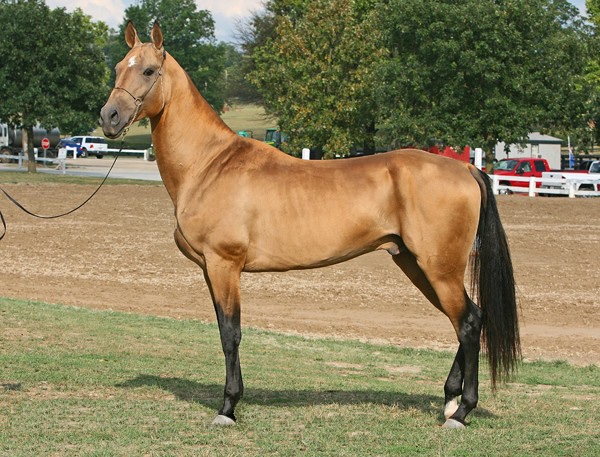
Physical Characteristics of the Akhal Teke
The Akhal Teke is a natural masterpiece, sculpted by its environment and history into a breed with distinctive traits that speak volumes about its adaptability and resilience.
The Graceful Build
- Height: Ranges from 14 to 16 hands (56 to 64 inches).
- Build: Slender and greyhound-like, enabling exceptional agility and speed.
- Appearance: Features a refined head, long neck, and expressive eyes, exuding elegance and alertness.
The Coat: A Natural Marvel
- Metallic Sheen: The Akhal Teke’s coat is renowned for its unique glow, a result of light-refracting hair structure, offering a shimmering effect.
- Color Variations: Includes bay, black, chestnut, and the iconic golden buckskin, each showcasing the breed’s signature luster.
Unique Features
- Eyes: Almond-shaped, reflecting a distinctive, intelligent look.
- Mane and Tail: Typically sparse, enhancing their streamlined silhouette.
- Adaptations: Thin skin and small, tough hooves, suited for hot, arid environments.
Akhal Teke vs. Other Breeds
Comparing the Akhal Teke to other breeds highlights its unique physical attributes and the evolutionary journey that has shaped this remarkable horse.
| Characteristic | Akhal Teke | Thoroughbred | Arabian |
|---|---|---|---|
| Origin | Turkmenistan | England | Arabian Peninsula |
| Height | 14-16 hands | 15-17 hands | 14-15 hands |
| Build | Slender, athletic | Tall, muscular | Compact, sturdy |
| Coat | Metallic sheen, various colors | Solid colors, often bay, chestnut, black | Commonly bay, gray, chestnut, black |
| Temperament | Intelligent, sensitive, loyal | Energetic, spirited | Intelligent, gentle, loyal |
| Best Suited For | Endurance, dressage, show jumping | Racing, show jumping, eventing | Endurance, show, pleasure riding |
| Notable Traits | Metallic coat, endurance | Speed, competitive spirit | Stamina, versatility |
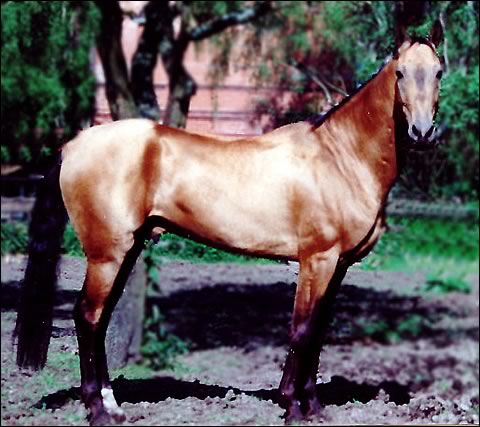
Breed Temperament and Behavior of the Akhal Teke
The Akhal Teke is admired for its physical beauty and distinctive temperament and behavior, deeply rooted in its historical background as a horse of the desert nomads.
The Essence of the Akhal Teke Temperament
- Intelligence: Akhal Tekes are quick learners and highly trainable, but they also require consistent mental stimulation.
- Sensitivity: They are responsive to their environment and handler, which can be a double-edged sword. This can lead to remarkable cooperation but also to skittishness if mishandled.
- Loyalty: Often forming a strong bond with a single person, they can be incredibly devoted, mirroring the deep connections they formed with nomadic riders.
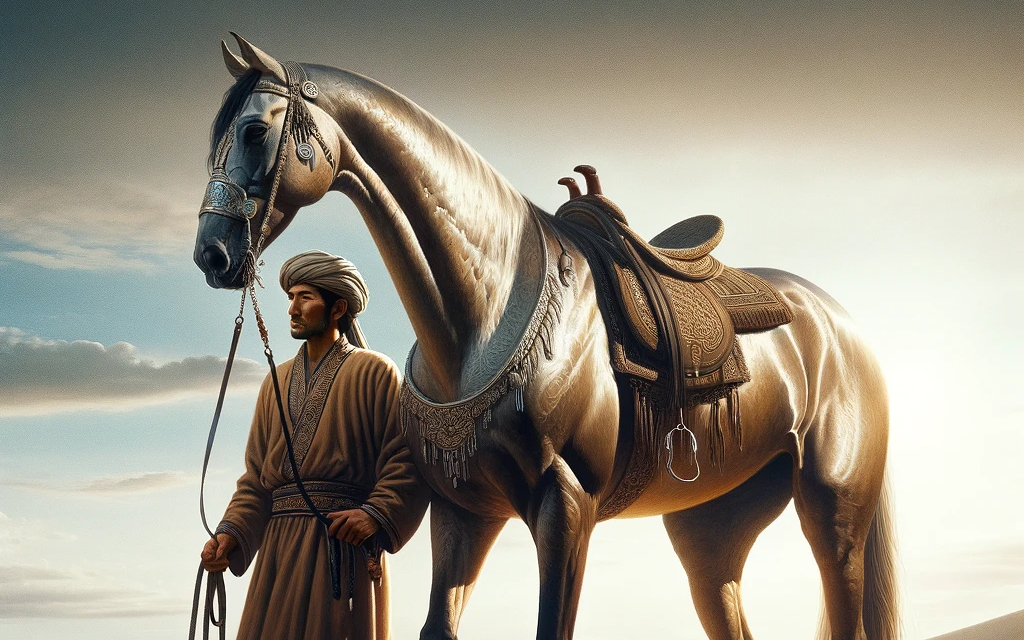
Behavioral Traits and Implications for Owners
Owning an Akhal Teke can be a uniquely rewarding experience, but it also comes with certain considerations:
- Need for Regular Exercise: Their athleticism and energy levels mean they require ample exercise and space to move.
- Handling Sensitivity: Due to their sensitivity, they respond best to calm, confident, and consistent handling.
- Social Interaction: They thrive on interaction with humans and other horses, making socialization an important aspect of their care.
Here’s a YouTube video about the history, characteristics, and care of the Akhal Teke horse breed.
Practical Care and Management of the Akhal Teke
Caring for an Akhal Teke, with its unique characteristics and needs, requires a thoughtful approach. Here’s a guide to the daily care requirements and tips for maintaining the health and well-being of this majestic breed.
Daily Care Requirements
- Grooming: Regular grooming is crucial for the Akhal Teke, not just for coat health but also for building a bond with the horse. Their thin skin and fine coat require gentle brushing to avoid irritation.
- Exercise: Given their high energy levels and athletic nature, daily exercise is essential. This can include turnout in a safe, spacious area, as well as structured exercise like riding or lunging.
- Hoof Care: Regular hoof checks and maintenance by a professional farrier are vital, considering their small, tough hooves adapted for desert terrain.
Health and Well-being Tips
- Diet: A balanced diet is key. Akhal Tekes do well on high-quality forage and may require supplements, especially if used for sport. Avoid overfeeding, as they are efficient feeders.
- Hydration: Ensure constant access to fresh water, as their desert heritage does not make them immune to dehydration.
- Shelter: Provide adequate shelter from extreme weather, despite their hardiness, to ensure comfort and health.
Step-by-Step Care Routine
To simplify the care process, here’s a step-by-step routine:
- Morning: Check water and food, morning grooming session, brief health check.
- Daytime: Turnout for free movement and socialization, or structured exercise.
- Evening: Evening feeding, grooming, and hoof check.
- Regular: Scheduled vet check-ups, deworming, and hoof care by a farrier.
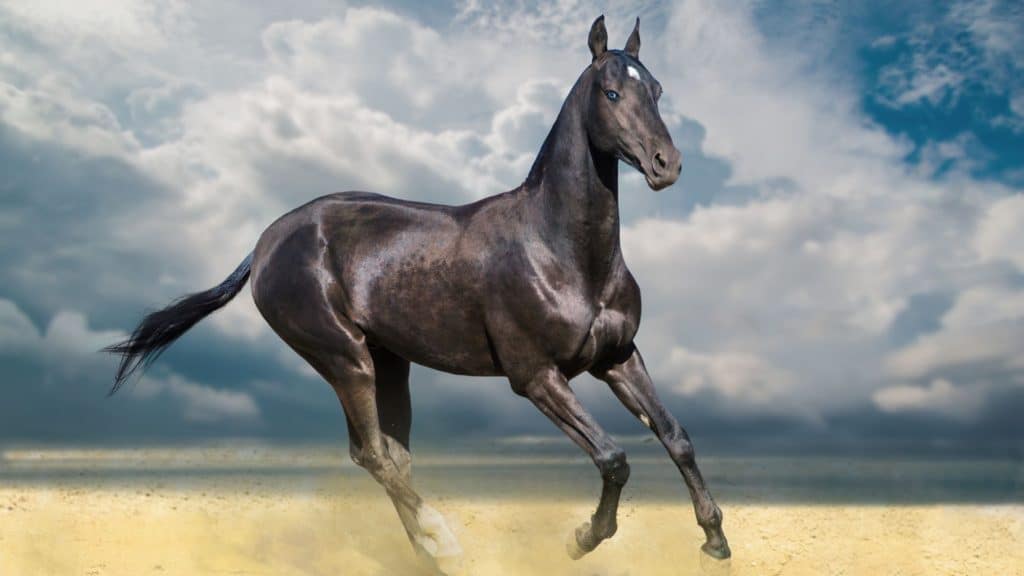
Health and Nutrition of the Akhal Teke
The Akhal Teke, known for its resilience and elegance, requires specific attention to health and nutrition to maintain its distinctive grace and athleticism.
Common Health Issues and Prevention Strategies
- Skin Sensitivity: Due to their thin skin, Akhal Tekes are prone to skin irritations and allergies. Regular grooming and prompt attention to any skin abnormalities are crucial.
- Digestive Sensitivity: They can be susceptible to gastric ulcers due to their sensitive nature. Stress management, regular feeding schedules, and a diet high in forage can help prevent this.
- Musculoskeletal Issues: As athletic horses, they may face joint and tendon issues. Regular exercise, proper warm-up routines, and joint supplements can aid in prevention.
Nutritional Needs and Diet Recommendations
- High-Quality Forage: Forms the basis of their diet, providing necessary fiber and nutrients.
- Balanced Protein Intake: Essential for muscle maintenance, especially for active horses.
- Vitamins and Minerals: Adequate vitamins and minerals are crucial, particularly if the forage quality is variable.
- Controlled Grain Intake: Grains should be given in moderation to avoid digestive issues.
Balanced Diet Plan for Akhal Tekes
| Meal Component | Amount | Purpose |
|---|---|---|
| High-quality hay or pasture | 1.5-2% of body weight | Primary source of fiber and nutrients |
| Commercial feed (if necessary) | According to weight/activity level | Additional energy and nutrients |
| Vitamin and mineral supplement | As recommended | To balance the diet |
| Fresh water | Ad libitum | Hydration |
| Salt and electrolytes | As needed | Electrolyte balance |
Training and Activities for the Akhal Teke: Harnessing Their Potential
Training an Akhal Teke, known for its intelligence and sensitivity, requires a nuanced approach. Here are some tips and insights into suitable activities and sports for this versatile breed.
Training Tips for Akhal Teke Horses
- Consistency and Patience: Due to their intelligence, Akhal Tekes respond well to consistent training methods. Patience is key, as they can be sensitive to new commands and environments.
- Positive Reinforcement: They thrive on positive reinforcement. Reward-based training helps in building trust and a strong bond with the trainer.
- Varied Training Routines: To keep them engaged, incorporate a variety of training exercises. Their intelligent nature means they can easily become bored with repetitive tasks.
Suitable Equestrian Activities and Sports
- Endurance Riding: Their stamina and agility make them excellent for endurance riding.
- Dressage: The Akhal Teke’s graceful movements and responsiveness are well-suited for dressage.
- Show Jumping and Eventing: Their athleticism and speed enable them to excel in show jumping and eventing.
- Pleasure Riding: They are also great for leisurely rides, showcasing their gentle and cooperative nature.
Video Demonstrations of Training Exercises
To better understand how to train an Akhal Teke, here is a YouTube video demonstration on Basic ground training exercises showcasing how to build trust and responsiveness.
Breeding and Genetics of the Akhal Teke: Preserving a Legacy
The breeding and genetics of the Akhal Teke are as fascinating as the breed itself. Understanding these aspects is crucial for preserving the integrity and unique qualities of this ancient lineage.
Insights into Breeding Practices
- Selective Breeding: Historically, Akhal Tekes were bred for endurance, speed, and agility. Modern breeders continue this tradition, focusing on preserving the breed’s distinct characteristics while ensuring genetic diversity.
- Breeding for Temperament: Alongside physical traits, breeders also emphasize temperament, aiming for intelligent, sensitive, and loyal offspring.
- Health Considerations: Responsible breeders prioritize health, screening for genetic disorders common in the breed to ensure the well-being of future generations.
Genetic Traits and Inheritance Patterns
- Coat Color Genetics: The Akhal Teke’s unique coat colors, including the metallic sheen, are a result of specific genetic combinations, which breeders carefully consider.
- Inheritance of Physical Traits: Traits like the breed’s slender build and height are inherited, with breeders aiming to maintain the standard while avoiding extremes.
- Genetic Health Issues: Awareness of genetic health issues like Naked Foal Syndrome is crucial. Breeders use genetic testing to make informed breeding decisions.
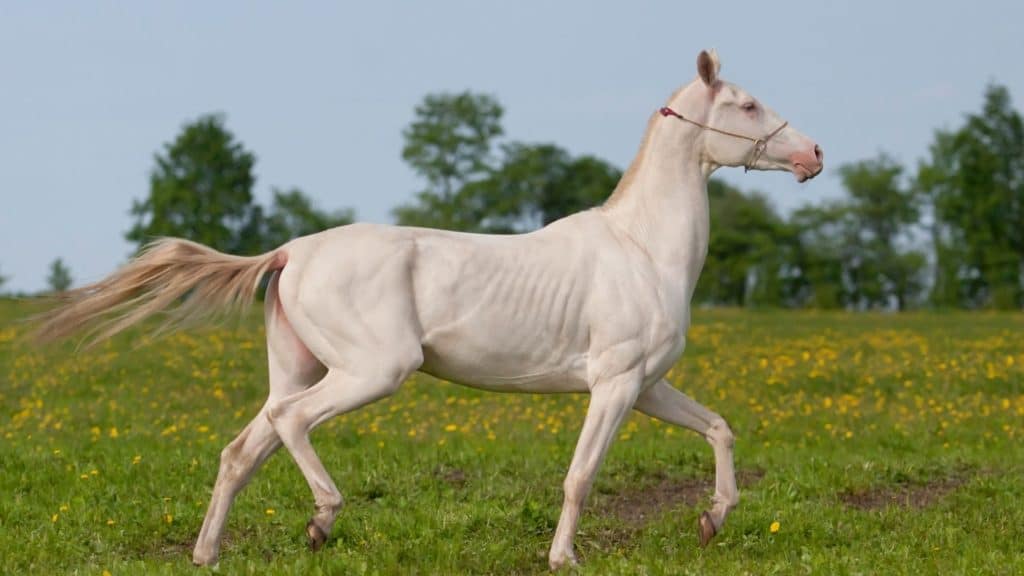
Uses and Roles of Akhal Teke
The Akhal Teke, with its distinctive elegance and history, has carved out a significant place in various domains, ranging from competitive sports to cultural symbolism.
Achievements in Equestrian Sports
The Akhal Teke’s grace and athleticism have captivated horse enthusiasts and led to remarkable achievements in various equestrian sports. This section celebrates their competitive spirit and highlights some of the breed’s most notable accomplishments and individuals.
- Endurance Racing: Akhal Tekes are renowned for their stamina, making them exceptional competitors in endurance racing. Their ability to cover long distances at a consistent pace has earned them numerous accolades in this discipline.
- Dressage: With their elegant movements and responsive nature, Akhal Tekes have also made their mark in dressage, showcasing their versatility and grace.
- Show Jumping and Eventing: Their agility and speed enable them to excel in show jumping and eventing, competing successfully at high levels.
Profiles of Notable Akhal Tekes in History
- Absent: Perhaps the most famous Akhal Teke, Absent won the individual dressage gold medal at the 1960 Olympics, becoming a symbol of the breed’s capabilities in the sport.
- Kambarbay: A modern example, known for his stunning palomino coat and success in show jumping and dressage.
- Polot: Renowned for endurance, Polot has set records in long-distance races, embodying the breed’s legendary stamina.
Photo of the Great Akhal Teke Absent
To truly appreciate the beauty and skill of the Akhal Teke in competition, here’s a picture of Absent in the 1960 Olympics, displaying impeccable dressage form.

Influence in Breeding and Cultural Impact
- Breeding Influence: The Akhal Teke has contributed to the development of other horse breeds. Their unique traits, particularly their speed and endurance, have been integrated into breeds like the Thoroughbred and the Trakehner, leaving a lasting impact on the genetic lineage of many contemporary horse breeds.
- Cultural Symbol: In Turkmenistan, the Akhal Teke is more than a horse breed; it’s a national emblem, symbolizing pride and cultural identity. Its depiction on national emblems, currency, and various art forms, from paintings to literature, speaks volumes about its cultural importance. Internationally, the breed’s striking beauty inspires artists and horse enthusiasts, cementing its status as a symbol of elegance and resilience.
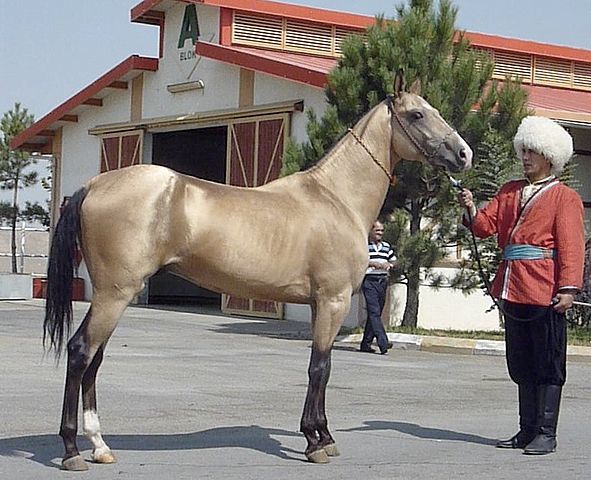
Buying Guide for Potential Akhal Teke Owners
Purchasing an Akhal Teke is a significant commitment that requires careful consideration. This guide aims to assist potential owners in making an informed decision, ensuring a good match between the horse and its new home.
Check out this YouTube video of various Akhal-teke Horses
Factors to Consider When Purchasing an Akhal Teke
- Purpose: Determine your primary purpose for the horse (e.g., competitive sports, breeding, leisure riding). Akhal Tekes are versatile but excel in certain disciplines.
- Temperament: Given their sensitivity and intelligence, assess whether the horse’s temperament suits your experience level and lifestyle.
- Health and Genetics: Inquire about the horse’s health history and any genetic tests, particularly for breed-specific conditions like Naked Foal Syndrome.
Estimated Costs and Ongoing Maintenance
- Initial Purchase Price: Prices vary widely based on age, pedigree, training, and purpose, ranging from $5,000 to over $30,000.
- Basic Care Costs: Include feed, boarding, routine veterinary care, and farrier services. Expect to spend approximately $200 to $500 per month.
- Training and Competition Expenses: If you plan to compete, factor in training fees, competition entry costs, and travel expenses.
Checklist for Prospective Buyers
To simplify the process, here’s a checklist for prospective Akhal Teke buyers:
- Verify Pedigree and Registration: Ensure the horse is registered and verify its lineage.
- Pre-Purchase Examination: Have a veterinarian conduct a thorough examination.
- Evaluate Training and Behavior: Assess the horse’s training level and behavior during handling and riding.
- Facility Visit: Visit the horse’s current living environment to observe its condition and care.
- Budget Planning: Prepare a detailed budget for initial and ongoing expenses.
Akhal Teke Community and Resources: Connecting Enthusiasts Worldwide
The Akhal Teke community is a vibrant and passionate group dedicated to the preservation and appreciation of this unique breed. Here’s a guide to getting involved and expanding your knowledge about the Akhal Teke.
Breed Associations and Clubs
- Akhal-Teke Association of America (ATAA): A key organization for Akhal Teke enthusiasts in the U.S., offering resources, event information, and a platform for connecting with other owners and breeders.
- International Akhal-Teke Association (IATA): Facilitates global connections among Akhal Teke enthusiasts, promoting the breed and organizing international events.
- European Akhal-Teke Association (EATA): Focuses on the breed in Europe, providing a network for breeders and owners and organizing shows and competitions.
Upcoming Events and Community Gatherings
- Annual Akhal Teke World Conference: A global event bringing together breeders, owners, and enthusiasts to share knowledge and experience and celebrate the breed.
- Regional Shows and Competitions: Various regional events offer opportunities to see Akhal Tekes in action and meet other enthusiasts.
- Breed-Specific Clinics and Workshops: Educational events focusing on Akhal Teke care, training, and breeding.
List of Resources for Further Reading and Learning
- Books:
- “The Akhal-Teke: Desert Horse to Olympic Champion” by N. Abramova
- “The Heavenly Horses” by T. J. Nelson
- Websites:
- Online Forums and Social Media Groups: Platforms like Facebook and Reddit have active Akhal Teke communities for sharing experiences and advice.
- Documentaries and Films: Various documentaries explore the history and beauty of the Akhal Teke, available on equestrian-focused streaming services.
How to Pronounce “Akhal Teke”
If you’re like me, you may find the spelling of “Akhal Teke” a bit challenging at first glance, leading to uncertainties about its pronunciation. To clarify, the correct pronunciation is akin to “ack-hull-tech-e.”
For an audio demonstration, you can listen to the correct pronunciation on Forvo, a website dedicated to word pronunciations. This resource can be particularly helpful if you’re looking to ensure accuracy in your pronunciation.
FAQs About the Akhal Teke
Can Akhal Tekes be good family horses?
Yes, with their loyal and gentle temperament, they can be great family horses, provided they receive proper training and care.
How can I start learning about Akhal Teke care?
Begin by reading reputable resources, connecting with breed associations, and speaking with experienced Akhal Teke owners and breeders.
What makes the Akhal Teke suitable for endurance sports?
Their slender build, efficient metabolism, and historical adaptation to harsh environments contribute to their exceptional stamina and endurance.
Conclusion: Embracing the Splendor of the Akhal Teke
As we reach the end of our exploration into the world of the Akhal Teke, it’s clear that this breed is more than just a horse; it’s a symbol of grace, endurance, and a rich history. From their striking metallic sheen to their exceptional athleticism, Akhal Tekes are not just horses for riders but treasures for enthusiasts and admirers alike.
The Akhal Teke stands out for its unique combination of beauty and resilience. Its adaptability to harsh environments, coupled with its elegant build and intelligent demeanor, makes it a breed like no other. Whether in competitive sports, leisure riding, or as a cherished companion, the Akhal Teke leaves a lasting impression on all who encounter it.
Owning and caring for an Akhal Teke is both a privilege and a responsibility. Their sensitive nature and specific care requirements call for knowledgeable and dedicated caretaking. Yet, the bond formed with an Akhal Teke is unparalleled, making every effort worthwhile.
Join the Akhal Teke Community
We encourage you to dive deeper into the world of Akhal Tekes. Whether you’re a seasoned owner, a prospective buyer, or simply an admirer, there’s always more to learn and share about this magnificent breed.
- Share Your Experience: Do you have an Akhal Teke, or have interacted with one? Share your stories and experiences in the comments below.
- Get Involved: Join local and online Akhal Teke communities to connect with other enthusiasts and stay updated on events and gatherings.
Stay Connected and Informed:
- If you found this guide helpful, consider signing up for our newsletter for more insights and updates on horses.
- For personalized advice or specific inquiries, feel free to contact me directly. I’m here to help.
Thank you for reading, and I look forward to connecting with you, whether it’s through our newsletter, direct communication, or in the comments section. Here’s to the thrilling journey of racehorse ownership!
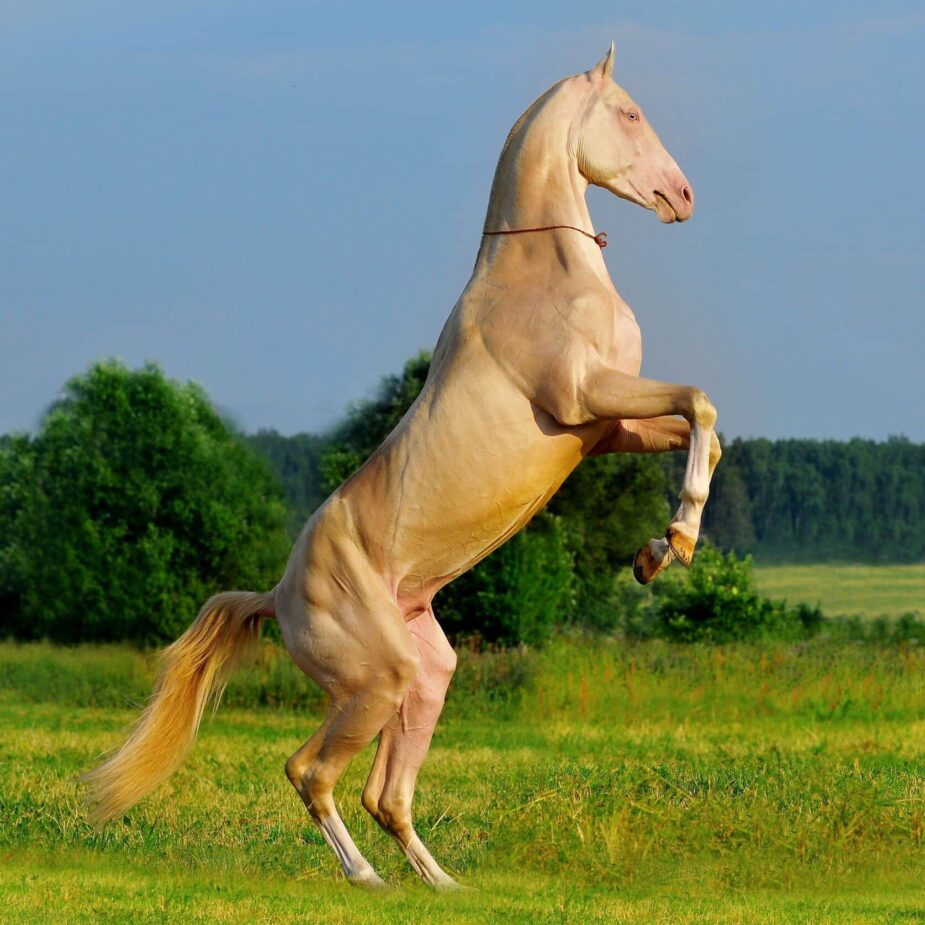
Reader Poll:

About the Author: Miles Henry
Lifelong Horseman | Racehorse Owner | Published Author
Miles Henry brings over 25 years of hands-on experience training and owning Thoroughbred racehorses. Raised with Quarter Horses and Appaloosas, he’s spent a lifetime learning from horses—on the track, in the barn, and in the field. Today, he runs a small but successful racing stable in Louisiana and shares real-world insights on HorseRacingSense.com, helping horse owners, fans, and bettors navigate the sport with confidence.
📚 Books: View Miles’s books on Amazon »
🎧 Podcast Guest: Animal Tales Ep. 32 |
YouTube Interview
📩 Newsletter: Sign up for racing tips and horse care advice »
🔗 Follow Miles:
Twitter |
Facebook |
YouTube




